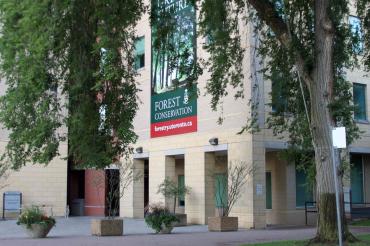New U of T proposal would see Faculty of Forestry join John H. Daniels Faculty of Architecture, Landscape, and Design

Published: December 17, 2018
A new proposal would see faculty, staff, and students from the University of Toronto’s Faculty of Forestry join the John H. Daniels Faculty of Architecture, Landscape, and Design as of July 1.
The academic restructuring proposal comes after a year and a half of extensive online and in-person consultations, and would result in a number of new faculty being hired in forestry-related fields.
Discussions with the academic units affected will be established and communicated by the deans of both faculties. Consultations will continue to take place until April. The proposal would go through the governance process beginning on May 9.
“We are strongly committed to using these consultations to identify the best structure for forestry-related academic programs at the University of Toronto,” says U of T Vice-President and Provost Cheryl Regehr. “Thank you to everyone who has taken the time to participate in this process thus far.”
The Faculty of Forestry currently has five full-time faculty members and one contractually limited-term appointee as well as 122 graduate students. Undergraduate students in the Faculty of Arts & Science can also pursue forestry-related courses and programs.
Under the proposed restructuring plan, there would be no reduction in the number of faculty or staff and no changes for graduate and undergraduate students enrolled in forestry-related courses and programs. Forestry will continue to be housed at 33 Willcocks St.
The proposal also includes the addition of five new faculty positions in forestry-related fields to allow integration into the Daniels Faculty’s various program offerings.
“These changes will ensure that forestry-related academic programs and research have a bright future at U of T, with the support and resources needed to remain sustainable and to flourish,” says Regehr.
“Combining the Daniels and forestry faculties will pave the way for more collaboration and interdisciplinary research,” says Robert Wright, the dean of forestry and an associate professor and former associate dean at Daniels. “It’s about how this would create true innovation and more opportunities for students.”
There are already a number of areas where architecture, design and forestry intersect, Wright says, including urban forestry and building with mass timber and other renewable building materials.
Forestry and timber research also play a vital role in supporting the university’s commitment to education and programming on environmental issues and initiatives, says Wright.
“With our faculties’ mandates around sustainability and climate change, there's a group of professionals who want to build cities sustainably and who are very interested in the science behind climate change, conservation, and ecology,” he says.
“This proposal also corresponds with U of T’s cities mandate and the fact that trees in cities are becoming very important aspects of urban infrastructure for the cities themselves.”
Beyond the Faculty of Forestry, researchers across all three campuses are engaging in forest science – from the Faculty of Applied Science & Engineering’s Pulp and Paper Centre to research at U of T Mississauga on the growth and management of urban forests and U of T Scarborough’s partnership with Parks Canada on the Rouge National Urban Park.



